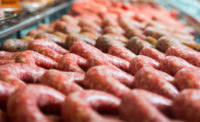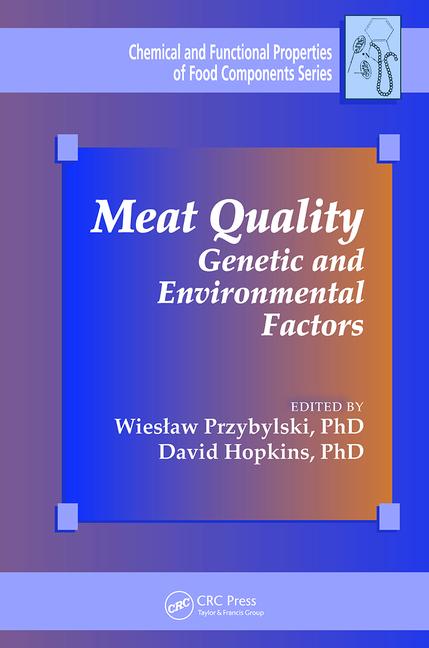Processing Tech
High-tech answers to slaughtering challenges
Slaughterhouses leverage newer technologies to become more productive and effective and to enhance animal welfare.




Slaughterhouse operations are evolving. Propelled by advancements in technology and methodologies, plants are producing higher quality proteins with a greater emphasis on food safety and the humane treatment of animals.
And with government regulators, third-party auditors and operators more closely scrutinizing plants, slaughterhouses are functioning more efficiently and effectively.
“Plants have never been better,” says Temple Grandin, professor of animal science at Colorado State University and a livestock industry consultant on facility design. “The U.S. Department of Agriculture has gotten really strict in monitoring the humane slaughter of animals, and the U.S. is much better than a lot of countries in that area.”
Slaughterhouses are leveraging myriad tools and techniques to enhance animal welfare and operations, including newer stunning apparatus.
Erika Voogd, president of Voogd Consulting Inc. — a West Chicago, Ill.-based consulting firm specializing in animal welfare, food safety, regulatory support and meat plant training — notes such equipment includes pneumatic captive bolt stun guns.
In search of straight shooters
The devices, which are geared for higher-volume plants, can be easily changed from a standard to a higher pressure setting for larger animals, such as older cattle and bulls.
Also available are handheld captive bolt stun guns for lower volume plants. The devices — which are designed for larger cattle, dairy cows, bulls, boars and older sows — have a longer barrel and penetrating bolt with more cartridge power to deliver ample force to effectively stun on the first shot, Voogd says.
A new captive bolt gun, meanwhile, has a fully retractable bolt and a heavier barrel for easier maneuvering. Such a bolt saves time and helps eliminate the possibility of the gun sticking in an animal’s head.
Advanced slaughterhouse technologies also are enabling plant operators to pinpoint the optimal points on cattle for stunning, Voogd says. “The best location is higher on the forehead and assures stun accuracy into the mid-brain,” she says.
Newer tools in the poultry sector, meanwhile, include guns that automatically adjust stunning amperage in accordance with a bird’s resistance and horizontal cones that hold birds in place and eliminate the need for hanging. Such gentle restraining during slaughter reduces stress and damage to wings and legs.
Another technique that is intended to reduce stress in birds is low atmospheric pressure system (LAPS) stunning. During the procedure, poultry are placed in chambers and rendered unconscious by a gradual reduction in the amount of oxygen in the atmosphere. It eliminates the discomfort associated with live-bird shackling.
The details are in the data
Cutting-edge technologies also are providing additional options for the electrical stunning of pigs.
Some devices, for instance, can detect a pig’s potential resistance to stunning and, in response, automatically adjust the amperage. Resistance can quickly change in accordance with such factors as how quickly tissue breaks down during the stun, the wetness and thickness of the skin, the amount of hair and the level of hydration.
Accurate assessments are essential as excessive amperage can cause broken bones, bruising and blood splash, in which blood leaks into muscles and causes discoloration. Such issues can affect product quality.
Technologies also enable stunning information and other slaughterhouse measurements to be automatically recorded on computer databases.
“Plants are becoming more data driven in looking for signs of animal insensibility as well as registering the accuracy of stun gun placement, amperage and voltage readings, and how long a stun lasts,” says Kurt Vogel, assistant professor of animal science at the University of Wisconsin in River Falls. “Monitoring stunning is like having a black box in that we can tell when something has gone wrong. Slaughterhouses, by collecting information, can catch potential problems before they become severe animal welfare issues.”
While more statistics give managers a clearer and more accurate assessment of plant operations, enabling them to make better decisions, it also creates challenges, Vogel says.
“Managers have more options to think about with the extra details,” he says. “The best operators will get information quickly and find ways to use it in a streamlined manner.”
Enhanced technologies, meanwhile, also are leveraged in niche sectors, including plants that specialize in the religious slaughter of animals.
A sharper cutting image
Joe M. Regenstein, professor of food science and head of the kosher and halal food initiative at Cornell University, says newer knife sharpening equipment is able to quantitatively measure the state of instruments.
Optimal blade sharpness helps reduce muscle and tendon strains in workers and limits such potential injuries as carpal tunnel syndrome during slaughter. Sharper blades also contribute to the humane treatment of animals, he says.
“With the proper sharpness there is less chance an animal will feel a cut,” Regenstein says. “It is important that the animal expires calmly and does not feel pain.”
Devices that measure knife sharpness are intended to replace such manual procedures as gauging the state of the blade with microscope examinations, Regenstein says, adding that methods which rely on qualitative rather than quantitative evaluation are often inaccurate.
“There are extremely strict rules for kosher slaughter, which includes having knives that are the right size, shape and sharpness,” he says. “It is critical that the knife is used correctly.”
In addition to upgrades in slaughterhouse tools and devices are advances in the monitoring of slaughterhouse operations by the U.S. Department of Agriculture (USDA) and plant administrators.
“The USDA is doing more enforcement on stunning and is tightening up its procedures, which includes giving out more noncompliance records and requiring plants to suspend operations,” Grandin says. “That level of activity was not happening just three years ago.”
Such added scrutiny was triggered in part by the release of an undercover video in 2012 that revealed animal abuse at a Central Valley Meat plant in Hanford, Calif.
And unlike the 1980s and 1990s when broken equipment was common and workers often abused livestock, Grandin says today’s slaughterhouses “have never been better,” though upgrades are not often acknowledged.
Missing the big picture
“College students and others go to Web sites and read about the bad things that have happened in the treatment of animals, but they don’t know what is occurring overall within the industry,” Grandin says. “It’s frustrating because there are improvements, but many people are not aware of them.”
Indeed, she notes that only within the last year have plants’ noncompliance records (NR) and suspensions been posted online for public access. With only recent data available, viewers are unable to compare the number of incidents with those in the past.
“The situation is getting better but Web sites don’t show history,” Grandin says. “In the early 1990s, there would have been 10 times more violations listed. Ten years ago the USDA never would have shut down a plant for a noncompliance violation, but that has changed.”
Grandin says the USDA is more closely monitoring stunning and, as a result, “stunning is getting to be about as good as it is going to get.”
Such measures as having outside parties monitor plant operations through video auditing also are contributing to greater animal welfare.
Third-party video audits are typically only leveraged by the largest plants and it solves the problem of many workers being on their best behavior only when they are watched by managers, Grandin says.
While such technologies enhance operations throughout plants, Grandin says there still is room for improvements.
For instance, many animals continue to be stressed by practices such as plant workers parking vehicles near fences holding livestock, having workers stand in front of animals as they move into chutes and causing lights to reflect off floors.
Future upgrades to slaughterhouses will likely be incremental and involve changes to employee behavior, Grandin says.
“Enhanced animal welfare often results from small alterations, such as eliminating distractions, changing handlers, not routing too many cattle and pigs into a chute at one time and being quiet with the animals,” she says. “People are always looking for the magic new technology for animal welfare, but it’s the management that will make the biggest difference.”
Further changes will likely include additional cutbacks in the use of electrical prods to route animals into chutes. Prodding often causes stress in cattle and results in tougher meat.
“Plant workers are becoming much better,” Grandin says. “Especially because the USDA has gotten stricter and will shut down a plant if there is too much electrical prodding.”
Focusing on less stress
Other stressful behaviors that affect product quality include the herding of animals into areas of plants and trucks that lack adequate space, which can cause discomfort and bruising. Added stress to pigs, meanwhile, can result in the development of pale, soft and watery meat because of increases in lactic acid and decreases in pH.
Technical enhancements, however, are also contributing to a better understanding of animal handling techniques by workers. Electronic training modules, for instance, enable new workers to become more easily versed on proper slaughterhouse procedures and current workers to stay current on the newer devices and methodologies.
Future advancements in technology and procedures, Voogd says, will address ongoing challenges, such as effectively handling animals that continue to increase in size and maintaining an efficient operation despite continuing employee turnover.
The growing breadth of animals, some of which is the result of genetic engineering intended to increase weight, contributes to greater stress because of inadequate plant capacity and equipment. (See sidebar).
Voogd notes, for instance, some slaughterhouses are using stun guns that were bought 30 years ago for 1,000-pound animals and are now are being used on 1,600-pound cattle. Such devices, she says, might cause concussions but not insensibility.
“There have been dramatic improvements in plants over the last 15 years, but the work is not done,” she says. “Slaughterhouse operations need to be managed like any process and it is important that the industry continue to move to a better direction and does not slip backward.”
Advanced technologies, along with greater government and plant oversight, have been instrumental in making slaughterhouse operations more productive and less stressful for animals. While future improvements will largely be incremental, additional enhancements to devices and animal handling procedures will further reduce the prospect of violations with subsequent upswings in animal welfare and food quality
Newer knife sharpening technologies enable workers to more accurately gauge the state of blades.
The heavy-duty captive bolt stun gun with a larger penetrating rod is best for bigger animals.
The growing size of animals is making it difficult for many to comfortably fit into restrainers.
A need for harvest, fab makeovers
While advancements in equipment are enhancing animal welfare and slaughterhouse operations, additional improvements also will result from non-technical changes.
A key focus will be the renovation of plants to ensure facilities can effectively handle larger sized animals without causing stress or effecting food quality.
Enhanced employee training also is on agendas as slaughterhouses seek to remain efficient despite rapid worker turnover.
“If any cog on a wheel is not working properly, things can go wrong in plants,” says Erika Voogd, president of Voogd Consulting Inc., a West Chicago, Ill.-based consulting firm specializing in animal welfare, food safety, regulatory support and meat plant training.
She says many plants are designed to accommodate small animals, yet the size of livestock has increased over the decades. As a result, some animals no longer fit in restrainers and cattle often are reluctant to enter chutes because they are afraid they will scrape their backs — an issue that can necessitate the use of electrical prods.
While many large plants have expanded to accommodate larger animals, some small- and medium-size slaughterhouses have yet to revamp their facilities.
“Many slaughterhouses were built 20 years ago to handle 180- to 200-pound pigs and now you are trying to put 260- to 300-pound pigs in the plants,” Voogd says. “Some facilities also have sharp corners, doors that are not tall enough and entrances that are not wide enough for the livestock. Trying to push animals through the doors and chutes can result in agitation and cause bruising.”
She notes, however, that the U.S. Department of Agriculture (USDA) is giving more oversight to the state of facilities and “the majority of plants are putting more emphasis on humane handling whether the slaughterhouse is small, medium or large.”
Handling, she adds, is particularly challenging as each animal can behave differently with workers. Some cattle, for instance, are comfortable with people while others might come from ranges where they encountered humans only once or twice a year and therefore are afraid of employees.
“There is a lot of worker turnover in plants and the new employees often don’t know how to work properly with the animals,” she says. “The employees need to be seasoned and understand the process to be effective.”
Voogd says it is crucial for new employees to be trained adequately prior to working with livestock or poultry.
“An effective method is for the workers to ‘buddy’ with mentor employees that are humane-handling champions with excellent skills and calm demeanors and who can make sure that newer employees receive the right guidance and instruction on the job,” she says. “It also is important that the new and existing employee are versed on procedures at both the start of their jobs and afterwards.”
Looking for a reprint of this article?
From high-res PDFs to custom plaques, order your copy today!










